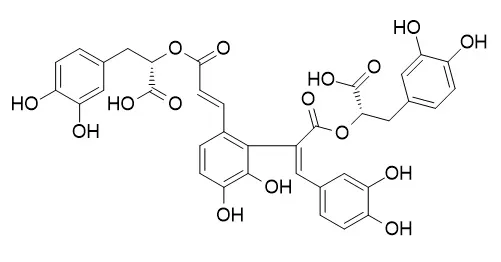| In vitro: |
| J Chromatogr B Analyt Technol Biomed Life Sci. 2016 Jun 1;1022:6-12. | | Development and validation of a UFLC-MS/MS method for determination of 7'(Z)-(8″S, 8‴S)-epi-salvianolic acid E, (7'R, 8'R, 8″S, 8‴S)-epi-salvianolic acid B and salvianolic acid B in rat plasma and its application to pharmacokinetic studies.[Pubmed: 27064533] | 7'(Z)-(8″S, 8‴S)-epi-Salvianolic acid E (compound 1) and (7'R, 8'R, 8″S, 8‴S)-epi-salvianolic acid B (compound 2), two novel analogs of salvianolic acid B (Sal B), have been recently isolated from Salvianolic acid for injection. They both show powerful antioxidant effects, including inducing NQO1 activity and scavenging DPPH free radical, and potential protecting effects for cerebral ischemia. However, no reports have been described the pharmacokinetic study of them.
METHODS AND RESULTS:
In this study, an ultra-fast liquid chromatography-tandem mass spectrometry (UFLC-MS/MS) method was developed and validated for the determination of compound 1, compound 2 and Sal B in rat plasma, respectively. Plasma samples were pretreated by liquid-liquid extraction with ethyl acetate. Chromatographic separation was achieved on a Waters Acquity UPLC(®) HSS T3 column (1.7μm particles, 2.1mm i.d.×100mm) with the mobile phase of 0.1% aqueous formic acid (A)-acetonitrile (B) (65:35, v/v). Quantification was performed on a triple quadruple tandem mass spectrometry with electrospray ionization (ESI) by multiple reaction monitoring (MRM) in the negative ion mode. Monitored transitions were set at m/z 717.0→519.0, 717.1→519.1, 717.2→518.9 and 320.9→152.1 for compound 1, compound 2, Sal B and chloramphenicol (internal standard, IS), respectively. Linear calibration curves were acquired over the concentration range of 2.0-1000ng/mL for the three analytes in rat plasma. The extraction recoveries, matrix effects, intra- and inter-day precisions and accuracies of the three analytes were all within acceptable limits. The validated method was successfully applied to the pharmacokinetic study of compound 1, compound 2 and Sal B after intravenous administration of 6.0mg/kg in rats, respectively.
CONCLUSIONS:
The results indicated that compound 1 and compound 2 were both eliminated more slowly than Sal B. Exposure levels of both compound 1 and Sal B were higher than compound 2 in the same dosage range. This study provided critical reference for the pharmacokinetic study of compound 1 and compound 2. |
|






 Cell. 2018 Jan 11;172(1-2):249-261.e12. doi: 10.1016/j.cell.2017.12.019.IF=36.216(2019)
Cell. 2018 Jan 11;172(1-2):249-261.e12. doi: 10.1016/j.cell.2017.12.019.IF=36.216(2019) Cell Metab. 2020 Mar 3;31(3):534-548.e5. doi: 10.1016/j.cmet.2020.01.002.IF=22.415(2019)
Cell Metab. 2020 Mar 3;31(3):534-548.e5. doi: 10.1016/j.cmet.2020.01.002.IF=22.415(2019) Mol Cell. 2017 Nov 16;68(4):673-685.e6. doi: 10.1016/j.molcel.2017.10.022.IF=14.548(2019)
Mol Cell. 2017 Nov 16;68(4):673-685.e6. doi: 10.1016/j.molcel.2017.10.022.IF=14.548(2019)